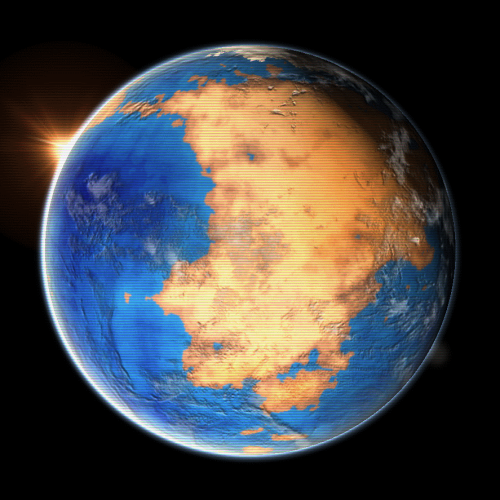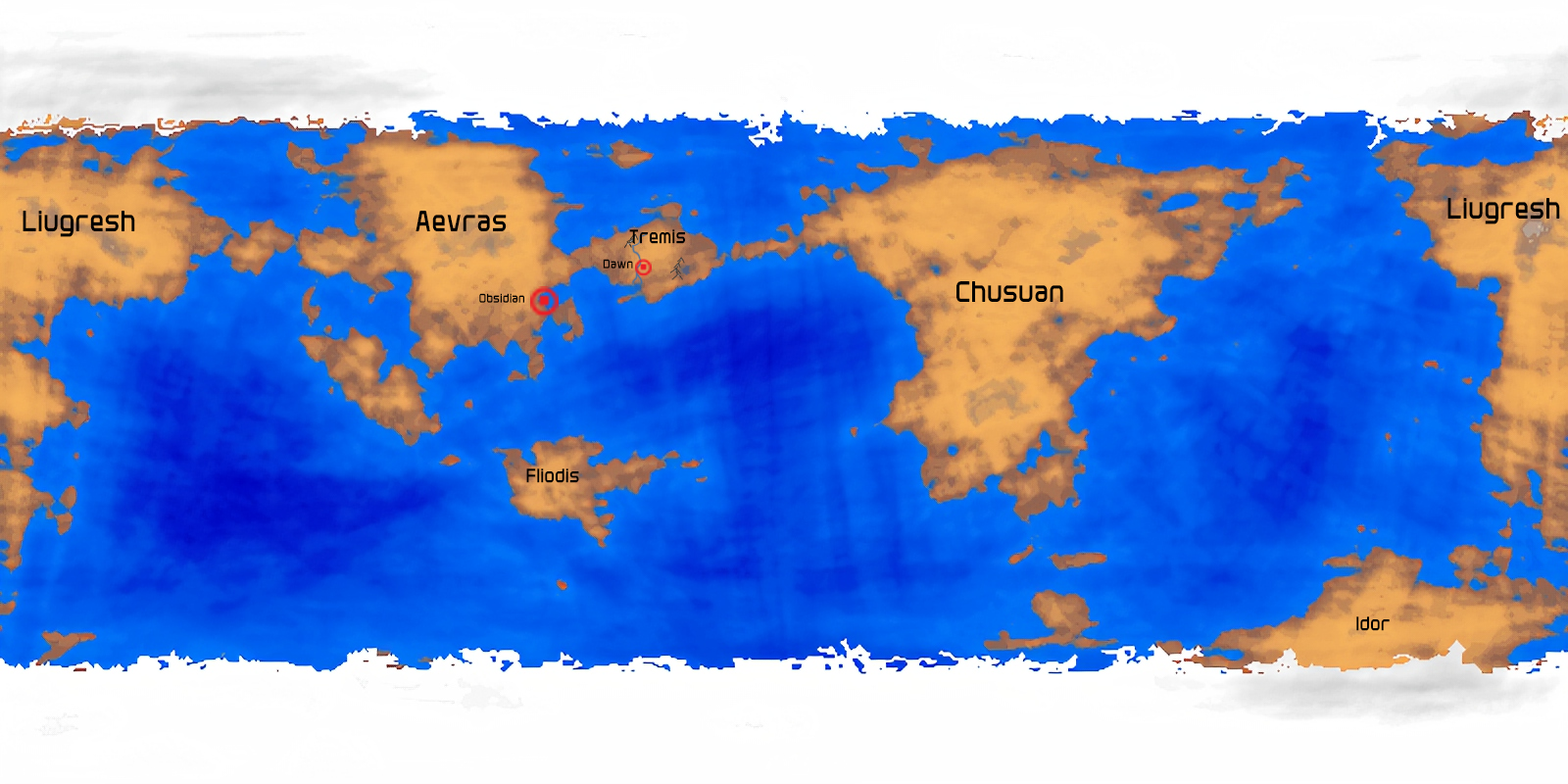Sidebar
Table of Contents
Sirris VI
Home to many sentient alien species extinct or living, Sirris VI is a safe haven of life. It is home to the Gunja and was once home to the Deceivers before they abandoned it in favor of staying hidden from the galactic community. Many other pseudo-human species evolved on this planet but went extinct before they could achieve space travel.
More about Sirris VI
This planet is the second planet of the Sanctum Star System; despite looking as though the whole planet is a badlands when viewed from space, it is in a habitable zone and is teeming with life - it simply appears that way because the majority of plant life is orange rather than green. Sirris VI's hydrosphere is 79% water and 31% ice. The equator is as uninhabitable as the polar ice caps due to Sirris VI's relatively insubstantial tilt; despite this, however, areas between the equator and ice caps have provided an adequate environment to foster life and thus have allowed ecosystems to expand out to these biomes as well.
Star
The star that Sirris VI orbits around has been named Sanctum by the New Dusk Conclave and is a type K4 orange dwarf.
Environment
Sirris VI is life rich and has a number of diverse biomes with complex ecosystems, including jungles, woodlands, tundras, mountain ranges, two polar ice caps, tropical isles, and deep oceans. Almost everywhere on the planet, plants are shades of orange and brown with occasional tints of yellow and red.
Life
The jungles of Sirris VI are vast and thick, yet sandwiched between the deserts, tundras, and oceans around them. Plant life bares similarities to the expected (ignoring that all of it is orange rather than green), including large trees and small shrubs, however, there are some notable species. One is a subterranean plant that literally lifts the earth up from above it. Similar to the woodlands, a small succulent stepable thrives in jungles and many other biomes; from a distance, it almost looks like fallen autumn leaves - and some would consider this plant to be Sirris VI's own grass. Many jungles of Sirris VI have also adopted a unique ecology where many plants and some animals benefit from bio-luminescence.
In terms of animals, an aggressive and persistent family of predators had made their way to the top due to pseudo-humans thriving on Sirris VI for quite some time: Man-eaters. These creatures sustained themselves on almost nothing but the flesh of intelligent animals and had the brain and brawn to boast it; fortunately, though, most of these man-eating species have been extinct for a long time due to the heavy decline of the pseudo-human population. Some ancient cousins still remain, but they aren't nearly as violent and usually hunt other animals; although this doesn't mean they won't attempt to hunt a pseudo-human, they will not do so if it isn't in their best interest.
Cities
The Gunja have a thousand or so relatively primitive cities underneath the planet's surface. However, as for the New Dusk Conclave, they have their capitol city here on the planet as the seat of their government. Obsidian City is a largely more clean and technologically advanced habitat compared to the rest of the planet, and host the majority of the nation's influxing population.
Dawn City is another smaller city located to the east of Obsidian City, notable for producing a large amount of Operators.
Stations
Gawain Station sits in orbit around the planet. It is a large, hollowed-out asteroid that acts as a staging point for the New Dusk Conclave's fleet forces in the Sanctum system. It features expansive fleet offices, training grounds, and supply facilities for the fleet. A large R&R area known as Jack's Crossing has restaurants, hotels, shops, and more to keep crew entertained between missions.
Population
The Gunja population in Sirris VI reached around 2,816,700,000 as of YE 40. There weren't any other intelligent species living on it until YE 41, when the New Dusk Conclave, moved in and took up a mutual and peaceful residency. Where as the Gunja far out number them, the NDC citizens only number in the millions currently.
Statistics
The following sections contain details about the various physical aspects of Sirris VI.
Physics
Below are the physical characteristics of Sirris VI.
Gravimetry
Below are the gravitational characteristics of Sirris VI.
Rotation and Revolution
Below are the orbital characteristics of Sirris VI.
Hydrosphere
Below are the aquatic characteristics of Sirris VI.
- Water: 79%
- Ice: 31%
Atmosphere
Below are the atmospheric characteristics of Sirris VI.
- Type: Breathable
Climate
Below are the climate characteristics of Sirris VI.
Map
OOC Notes
Lijosu created this article on 2018/08/29 21:34; approved it (using the checklist) on 2018/09/27 17:37.
| Places of the SARPiverse | |
|---|---|
| Opened/Settled (YE) | YE 41 |
| Place Categories | planet |
| Risk Level | safe |
Page Tools
Terms of Service - Privacy Policy


